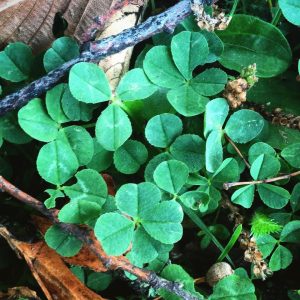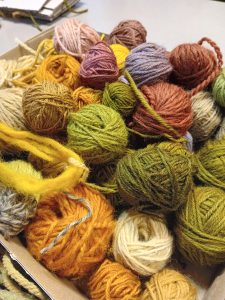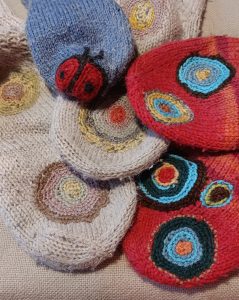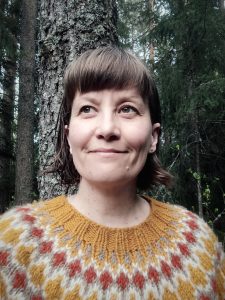Katri Pajala's fall courses at Aurala Civic College invite participants to stop, look, try and enthusiast. Recycling, natural materials and making with hand are combined with Katri's guidance to experiential learning, where the most important thing is not the finished outcome, but the journey - and what happens to be found. We interviewed Katria about the fall courses.
What inspires you to teach this topic?
I am an incurable hangover and I always miss a little project on my hands or at least on the bottom of my mind.
In a well -equipped craft shop, I might have left me in the past, I immediately wanted to start a thousand different projects and, of course, get the equipment right away ... Fortunately, the lack of money often saved from stupid procurement, but gradually I started to get a new item - is it really necessary? Can't the fun, insightful, useful things just do something that goes over or otherwise unused?
We live with all kinds of material, almost drowning in it, so it started to feel crazy about buying brand new (often some very far -reaching) materials for my little work. Even today, I need a new crafting bottle or even a watercolor brushing from time to time, but the more I have added a recycling perspective to my projects, the more rewarding it has become. For example, cleaning the surrounding area has also become "treasure hunting" as I look around with the pleasure of what to use. I want to share these insights, and I am also quite sure that all students have the same sharing.
What do participants usually be surprised to learn?
The most surprising thing about plant dyeing is probably its ease. I dreamed of the yarns I was planting for years and apricot, I could learn how to color the plants and how much and a variety of tools it would require. Until then I just decided to try and noticed that coloring as "home needs" is easy and fun. It is quite different to dye big items on plants, for example, for commercial purposes - then a lot of know -how, accuracy and equipment is needed to make the coloring batches uniform. But if you want to take advantage of the threads that rotate in the cabinet corners (or even the losing glove yarns) for a fun patching project, with vegetable colors, you can get a beautiful uniform "color palette" in your hands and almost entirely in the home kitchen. And let's enjoy a nice collection trip and get to know your close nature better.
big items on plants, for example, for commercial purposes - then a lot of know -how, accuracy and equipment is needed to make the coloring batches uniform. But if you want to take advantage of the threads that rotate in the cabinet corners (or even the losing glove yarns) for a fun patching project, with vegetable colors, you can get a beautiful uniform "color palette" in your hands and almost entirely in the home kitchen. And let's enjoy a nice collection trip and get to know your close nature better.
I have never been able to take trash and recycling courses before. I hope the participants are happy to surprise the same things that I themselves will always be surprised again: how random finds suddenly begin to "talk" with each other, and make imaginative insightful combinations. Sometimes it's almost like magic!
Who did the courses fit?
It may be easier to say that the courses do not fit for a person who wants to get ready -made accessories and precise instructions, when chewed, directly carried in front of the nose. In all autumn courses, collecting, choosing and creating your own material plays a big role- early autumn, tours are gathered in the nearby nature, more indoors in November and December in the darkness of November and December. I do my best, I am excited about the ballot of ideas and show examples of what solutions have worked for me and many others - but in the end, each participant is the chief designer and supervisor of his or her own project.
What is the best moment you have experienced as a teacher?
There are good memorable moments whenever we learn and realize new things, but a very touching moment happened in the winter in the winter, as we and the group we cooked and remembered where the shade had got in the yarn. One group member had had to deal with a big giving up in his life, and he told him that he had somehow a symbol of that sad season - he spotted cones on walks as well as other, for example, beautiful pictures of different kinds of snacks hit his eyes everywhere. This course had become familiar with Lepä's cone, where we got a wonderful strong orange -brown tint. Probably all of us had a tear around the table as he planned how to take this wonderful color (and good memories of how the pine cones were collected and yarns together) into their sad memories, associate the thread into his handicraft, and then a little more ready to continue his sad experience in life. Natural materials and handmade always give joy to life, but they can also work on very heavy experiences and memories.
Why is this skill important in life? Of course, a modern man does not need anything to do with plant dyeing! But I think that noticing the possibilities of our own environment, doing things, creating things, and sharing in a group are the very ultimate species that we have for people. And this is no longer any noise of the sting - the more precisely the well -being effects of nearby nature are being investigated, the more convincing data is. As you move openly in the immediate vicinity, you learn how to know the growing sites of the plants to be collected, or even clean up the trash of an important nature destination, and still creatively utilize the materials they have collected, give yourself a great gift. Rooting in one's own environment and inventing creative solutions with crafts creates a wide range of well -being throughout life.
Of course, a modern man does not need anything to do with plant dyeing! But I think that noticing the possibilities of our own environment, doing things, creating things, and sharing in a group are the very ultimate species that we have for people. And this is no longer any noise of the sting - the more precisely the well -being effects of nearby nature are being investigated, the more convincing data is. As you move openly in the immediate vicinity, you learn how to know the growing sites of the plants to be collected, or even clean up the trash of an important nature destination, and still creatively utilize the materials they have collected, give yourself a great gift. Rooting in one's own environment and inventing creative solutions with crafts creates a wide range of well -being throughout life.


